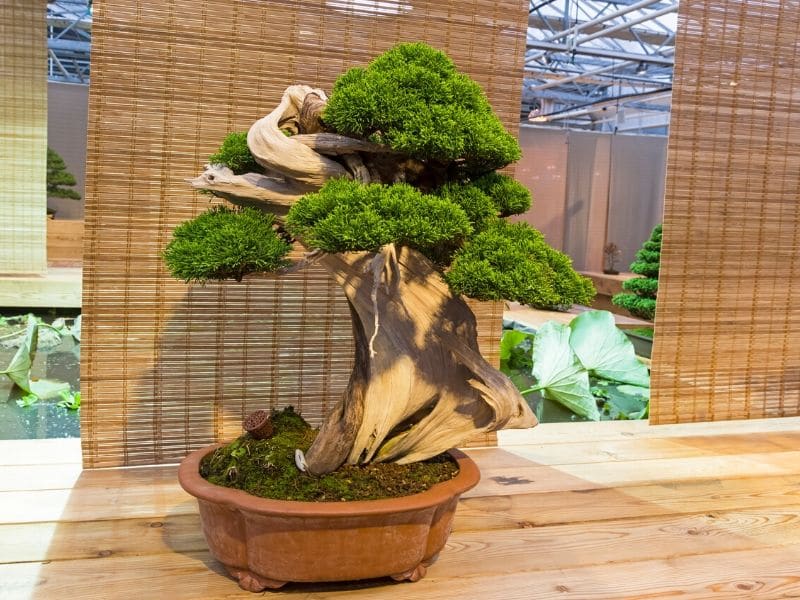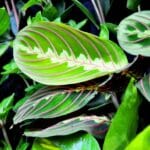Did you know that Juniper Bonsai trees come from the Cypress family of plants, and there are at least 70 tree species related to it?
Junipers’ can either be a tree or a shrub, and they are also evergreen coniferous trees, which basically means they are needle-leaved (similar to pines, firs, and spruces).
They could reach up to 16 feet in height if their necessary survival conditions are met, and they usually produce a wood that is tinted red, which makes it a great source of material for cabinets and any other type of wood furniture.
What’s more, this bonsai plant also produces a type of berry that is often used in Scandinavian countries to add spice to their traditional dishes.
Juniper bonsai trees are perfect for beginners who are jumping into the world of bonsais as they are relatively easy to grow and to maintain.
And, did you know that junipers like to be left out? Not only can they be raised outdoors or indoors, although most of them will thrive best if you leave them outside, they also prefer to be left alone, and they end up minding their own business.
Even though this may sound odd, junipers prefer to be left alone!
Are you ready to learn about juniper bonsai trees? Are you looking into getting one? Then this article is for you, continue reading and discover everything you need to know about these bonsai trees:
Types of Juniper Bonsai
Junipers can be divided into two groups: one that has scale-like foliage and another one with the needle-like foliage. This last type of juniper is the most common one worldwide.
Scale-like foliage
These are the most common Juniper types:
Chinese Juniper (Juniperus Chinensis)

It’s a small bonsai that can withstand climate change. They prefer to be fully exposed to the sun, and they also need well-drained soil in order to thrive. Unlike other bonsai trees, the Chinese Juniper doesn’t like being pruned, in fact, they can be affected by this.
Japanese Savin
Even though its name says ‘’Japanese’’, this type of juniper can be found in North-Africa, Asia, and Europe. Its foliage has different shades of green, depending on where the tree is located.
What’s interesting about this juniper is that it is extremely poisonous, so you should never keep one in your house and you should never have one if you have children or pets.
California Juniper
It’s a small shrub that has grey-bluish foliage. It’s native to North America, and, as its name suggests, it can be found in California.
It will thrive best if it’s located at an altitude of 1,200 meters or above. This juniper can reach up to 26 feet in height, and it’s a monoecious plant, which means it has both sexes on the same tree.
Needle-like foliage
These are the most common types:
Japanese Shimpaku (Shimpaku Itoigawa)
It is native to the Japanese mountain range. It’s very similar to the Chinese Juniper (Juniperus chinensis ‘Shimpaku’), as they both have the same type of foliage and have yellowish-green leaves. It’s a dwarf juniper and is sometimes used as a decoration piece.
It’s a very hardy bonsai, and it tolerates even the most extreme climates. It is a dioecious tree, which means it can produce only one organism, so it’s either male or female.
Rocky Mountain Juniper (Juniperus scopulorum)
It tends to grow in North America, and it’s a small tree. It has dark foliage and it needs to be on dry soil in order to thrive. It prefers higher altitudes of 2,000 meters or more. Even though its older leaves are very scale-like, it’s youngest leaves tend to be needle-like.
Apparently, this type of juniper can last a very long time, and there are some Rocky Mountain Junipers that are 1,500 years old.
Sierra Juniper (Juniperus Occidentalis)
Also referred to as the Western Juniper, this tree is native to the United States, and it usually grows in the mountains, especially in those that have a high altitude of almost 10000 ft or 3,000 meters. Its foliage is exceptionally abundant. They prefer dry soils and hot temperatures.
Green Mound Junipers
It’s a Japanese bonsai tree that has short foliage, and it tends to be bluish-green. It can be very invasive if it’s not taken care of properly. It’s straightforward to grow, and it can help to clear the air from pollution.
Japanese Needle Juniper (Juniperus Squamata)
Also known as the Himalayan juniper, it’s one of the most striking bonsai trees! Its foliage resembles needles. They are dark green and tend to have a white line that goes alongside the length of the leaf. It must be grown outside as it needs at least six hours of sunlight every day.
Juniper Bonsai Care
Now you know a little bit more about juniper bonsai trees, are you ready to take care of your bonsai? Here’s everything you need to know:
How to grow a Juniper Bonsai Tree?
Most bonsai growers will tell you that Junipers can grow perfectly well indoors or outdoors.
However, they do need plenty of sunlight (which could be six to eight hours a day), and they need to have a stable humidity (this means the weather shouldn’t be too dry nor too humid).
If you live in an area with hard winters, then place your bonsai inside. You should always protect it, especially if temperatures drop. You could either buy an already established juniper bonsai tree or you could reproduce one from the seed; either way, they will also thrive best if their soil is dry.
Maintenance of a Juniper Bonsai Tree
Should you fertilize your Juniper Bonsai Tree?
Yes, you should fertilize your Juniper bonsai; however, you should only do it once a month, if that. Sometimes, especially during the summer months, your juniper will be receiving everything they need from the atmosphere and the soil, so you don’t need to fertilize it as often.
Did you know that bonsai trees remain dormant during the winter? This is why you will need a fertilizer that has low levels of nitrogen, especially during the fall, because your bonsai will be dormant throughout the following season.
Should you prune and wire your Juniper Bonsai Tree?
Yes, you should do both. You can carefully cut some of the long sticks that come out of the base; you could use some sharp scissors to do so.
So, whenever you need to prune your juniper, do so at the bottom of the tree, otherwise, you will risk your bonsai as it doesn’t tend to grow well from bare tree parts.
On the other hand, if you have purchased a juvenile juniper bonsai tree then you shouldn’t do any other type of work on it as they are probably already heavily wired.
You don’t want your juniper to look like broccoli! So always do your research and look around for inspiring images and tutorials that can teach you how to trim and prune your juniper bonsai tree correctly.
What about repotting your Juniper Bonsai Tree?
If you are growing a juniper from seeds, then you will have to wait at least another two years to repot it. However, if you are purchasing an already juvenile or established bonsai, then you should repot it every three to four years. Lastly, if you are buying an old bonsai tree, then you should repot it every two years as well.
Always be careful with its roots as you don’t want to be aggressive when taking them out as they could easily break.
In addition, you should know that junipers will grow more beautiful and robust if you grow them in the ground, so if you happen to have a garden, then consider placing them directly into the soil.
How often should you water your Juniper Bonsai Tree?
This type of bonsai tree is perfect for those individuals who always forget to water their plants! Seriously, it is that easy to maintain and take care of because it’s not like any other type of bonsai tree.
In fact, junipers can dry out between getting water, and nothing will happen to them as they have the ability to withstand challenging climate conditions.
However, you should water it twice a month, so preferably every two weeks.
And how do you determine when your juniper needs more water? You should place a finger or two into the soil and see what it feels like. Is it completely dry? Is it flooded? Is it only damp?
So, if it’s damp, then the soil is still wet, and you don’t need to water it anymore. If it’s wholly flooded, then you have drowned your bonsai, so try to take some of the water out or try to place more soil. If it’s scorched, then water your bonsai!
Another important aspect is that you need to make sure your bonsai is able to drain properly, so try to have a pot that can allow them to do so. Otherwise, their roots may rot.
You should have a spray bottle to spray the foliage. Try to be gentle when you do this as you don’t want to overdo it, especially if you just repotted your bonsai.
Always remember that junipers need a certain level of humidity in order to grow correctly without lacking all the necessary nutrients, so, always observe your juniper closely to see if they are looking odd or if they have any problems.
FAQs
Where can I get a Juniper bonsai tree?
Nowadays, you could easily purchase your next Juniper online! However, they are also sold at large stores and even in most nurseries or from specialized bonsai retailers. Do your research and find out what type of bonsai best suits you.
Do Junipers get sick?
Yes, junipers can be susceptible to various diseases and pests. Common issues include fungal diseases like cedar rust and blight, as well as infestations by spider mites or bagworms. Proper care, such as providing well-drained soil and adequate spacing, can help prevent many of these issues.
How many hours of sunlight does a Juniper tree need?
Juniper trees generally thrive in full sunlight and benefit from at least six hours of direct sunlight per day. Providing them with ample sunlight ensures healthy growth, proper development, and vibrant green foliage.
How to identify a Juniper Bonsai Tree?
Identifying a Juniper bonsai tree involves observing its distinctive features, such as scale-like foliage arranged in whorls along the branches, the characteristic blue-green to dark green color of the needles, and the often gnarled and twisted trunk. Additionally, Juniper bonsai trees may display small, berry-like cones, further aiding in their identification.
Conclusion
Juniper bonsai trees are loved worldwide! They are one of the most well-known trees in nature, and they are definitely an all-time favorite for bonsai lovers.
The reason why people love this tree is that they can adapt quickly to any type of environment, they have flexible branches that allow bonsai enthusiasts to quickly learn how to trim them and prune them, and they tend to grow faster than other types of bonsai trees.
You will definitely have fun growing this tree, and you may even come addicted to the world of bonsai trees!
*Photo by possum/depositphotos







